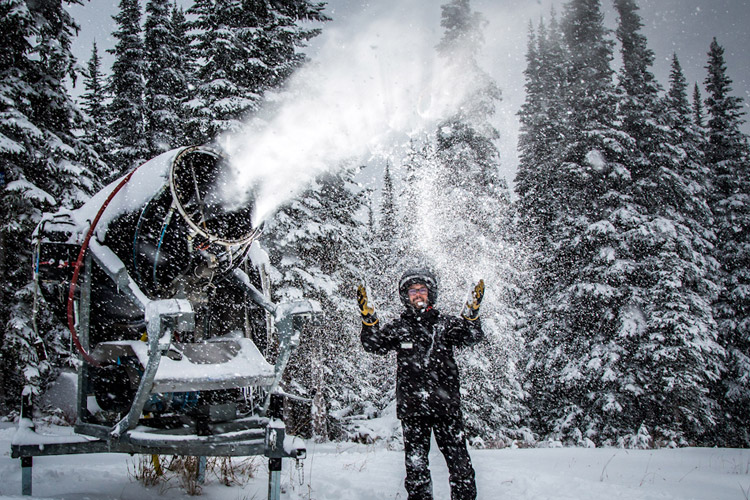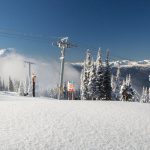“Look at it this way,” explains Pat Labrosse. “It’s like if a farmer could plant a magic crop then come back in four hours and the fields are waist high. On a cold night you can really see the progress happening, and it’s very satisfying.”

MITCHELL WINTON/COAST PHOTO
Pat is the Senior Supervisor of Snowmaking Operations for Whistler Mountain, Heather Dufty holds the same title for Blackcomb. And as the temperatures drop this time of year their 34-member ops crew will be working 24-hours a day to assist Mother Nature as she dresses North America’s number one ski resort in her finest white ball gown. But there are plenty of choices to be made as to what goes where.
“Providing the temperature and relative humidity are cooperating we have the ability to make five grades of snow,” Heather says. “5 is slop and 1 is nice dry, man-made pow. This time of year are making at least a 3, not too wet but once it is pushed out over the run it cures harder, almost like a cap over the run. Then as we get closer to opening day we make a drier nicer product for skiing on.”
That solid “cap” is one of the reasons Whistler Blackcomb’s base will last so late into the spring and this time of year Heather and Pat are constantly watching the weather in order to adjust where and when the snow guns can fire up. “We are maximizing every big of cold we can and preparing as much as possible,” Pat says. “Constantly monitoring the forecast and scheduling teams. When you get a window you want to be set up and ready.”
Snowmakers operate in two-person teams and work twelve hour shifts around the clock. With 280 snow guns in their fleet Whistler Blackcomb has the capability to make snow from the glacier right to the valley bottom. Of course working with that much vertical presents unique challenges as well.

LEFT: MITCHELL WINTON/COAST PHOTO. RIGHT: FEET BANKS PHOTO
“A cloud can roll in and push up against the mountain and change the temperature or relative humidity,” Heather says. “We operate off a wet-bulb temperature reading, not a dry bulb like standard thermometers. So if humidy is low enough we can make snow in postivie temperatures. For example, with a dry temperature of plus 3 and a realtive humidity of 13% the wetbulb is actually -3. Our job is to chase the weather from the glacier to the valley and ensure each gun is making the snow we want. It can be a rabbit hole of snow and atmospheric science.”
The ideal snowmaking conditions would be around -12° C with low humidity. Snow guns on Whistler Mountain are more spread out and Blackcomb has more automated guns that can be operated from a central computer in the valley, but both Heather and Pat stress the importance of boots on the ground. “Stuff freezes up,” Pat says. “Or if there is a power outage the snow stops but the water doesn’t. You need people up there; the mountains can always throw curveballs. And if our job goes unnoticed by the guests that means we are doing it right.”
In lean snow years the Whistler locals certainly notice (and applaud) the snowmaking efforts, and Whistler and Blackcomb crews do have a friendly rivalry to see who can get runs to the valley open the earliest. There is a unique camaraderie that builds among snowmakers as they watch their mountain get whiter with each passing shift.
“It’s amazing just to be out on the mountain on a cold night,” Heather says. “Sunrises, sunsets, communicating just with headlamps and hand signals; everything is quiet and empty and dark…”
Teams travel by snowmobile at night and ski or board to each gun in the day. They carry temperature and humidity measurement devices and can be responsible for 30-80 guns at a time. It’s physical work and much of the job involves unburying or “daylighting” the water hoses and electrical so they don’t get lost in the pow, manmade or natural.
“We’re out here to support Mother Nature, not replace her,” Pat says.
“If it is going to dump 20-40 cm overnight we might not work,” Heather agrees. “On a big storm system we might coil or strip the hoses and let it snow. The rest of the time, it’s just nice to be on the mountain, out amongst it and creating a product that brings a lot of people a lot of joy. ”

MITCHELL WINTON/COAST PHOTO
On an average year, Whistler Blackcomb snowmaking team turns create 650 to 900 acres of one foot deep snow. That’s a lot of joy to go around.
Come taste that wintery joy yourself. Everything you need is at Whistler.com


